Health Workers' Role in Indigenous Australian Communities: Analysis
VerifiedAdded on 2021/04/21
|9
|2310
|47
Essay
AI Summary
This essay explores the pivotal role of health workers in improving the well-being of Indigenous Australians. It begins by highlighting the challenges faced by Indigenous communities, including inadequate healthcare, high mortality rates, and cultural differences. The paper emphasizes the importance of understanding Indigenous cultures, traditions, and historical contexts to provide effective healthcare services. It discusses the significance of courses like Introduction to Indigenous Australia in educating health workers about cultural sensitivity and the importance of incorporating Indigenous health workers into healthcare teams. The essay also examines the impact of historical and cultural factors on Indigenous health, including the effects of colonization, discrimination, and environmental changes. Furthermore, it addresses ethical considerations, cultural diversity, and the need for health workers to be aware of their own biases. The conclusion reiterates the critical role health workers play in improving health outcomes and fostering respectful and culturally appropriate healthcare practices within Indigenous communities.

Running head: HEALTH WORKERS AND INDIGENOUS AUSTRALIANS 1
Health workers and Indigenous Australians
Name
Institution
Date of submission
Health workers and Indigenous Australians
Name
Institution
Date of submission
Paraphrase This Document
Need a fresh take? Get an instant paraphrase of this document with our AI Paraphraser

HEALTH WORKERS AND INDIGENOUS AUSTRALIANS 2
Introduction
The Indigenous Australians involve a group of people that descended from various
individuals who were living in Australia as well as the surrounding islands before Australia was
colonized by British. They are majorly the Torres Strait Islander and Aboriginal (Carlson, 2010).
Compared to the White Australians, the Indigenous people face many challenges such as
inadequate health care, education, and infrastructure. The death rate of these Indigenous people
is significantly higher as well as the cases of morbidity and mortality. Such cases have been
attributed to the reluctance of the Indigenous people to seek palliative and health care services.
The Indigenous communities have rich cultural ideologies that need to be understood by various
professions such as the health workers (Couzos & Murray, 2008). This paper, therefore,
describes the role of health workers in enhancing the livelihood of Indigenous Australians, the
significance of their cultural ideologies, and effect of cultural diversity and differences in the
community.
The significance of Course like SCS130 to health workers
Introduction to Indigenous Australia is a course of uttermost importance to health
workers. It helps one understand the culture of the Indigenous communities and hence get
insights on how to handle them. It explains how Indigenous Australia came about as well as how
their culture influences their day-to-day activities. Since the colonization period, the Torres Strait
Islander and Aboriginal are known to be the First Nation people of Australia (Colley, 2002).
Despite being the minority and facing racism challenges, the population of Indigenous Australia
keeps on growing. Most of these people live in urban centers especially in Queensland and New
South Wales. Nevertheless, some are found in the remote and rural areas.
Introduction
The Indigenous Australians involve a group of people that descended from various
individuals who were living in Australia as well as the surrounding islands before Australia was
colonized by British. They are majorly the Torres Strait Islander and Aboriginal (Carlson, 2010).
Compared to the White Australians, the Indigenous people face many challenges such as
inadequate health care, education, and infrastructure. The death rate of these Indigenous people
is significantly higher as well as the cases of morbidity and mortality. Such cases have been
attributed to the reluctance of the Indigenous people to seek palliative and health care services.
The Indigenous communities have rich cultural ideologies that need to be understood by various
professions such as the health workers (Couzos & Murray, 2008). This paper, therefore,
describes the role of health workers in enhancing the livelihood of Indigenous Australians, the
significance of their cultural ideologies, and effect of cultural diversity and differences in the
community.
The significance of Course like SCS130 to health workers
Introduction to Indigenous Australia is a course of uttermost importance to health
workers. It helps one understand the culture of the Indigenous communities and hence get
insights on how to handle them. It explains how Indigenous Australia came about as well as how
their culture influences their day-to-day activities. Since the colonization period, the Torres Strait
Islander and Aboriginal are known to be the First Nation people of Australia (Colley, 2002).
Despite being the minority and facing racism challenges, the population of Indigenous Australia
keeps on growing. Most of these people live in urban centers especially in Queensland and New
South Wales. Nevertheless, some are found in the remote and rural areas.

HEALTH WORKERS AND INDIGENOUS AUSTRALIANS 3
Indigenous communities all over Australia are known to suffer from various illness and
diseases. The death rate of this group is among the highest numbers in the whole world. Despite
the fact that death is experienced across all age groups, it is most pronounced between the age
range of 25-45 years. Where compared to the non-Indigenous Australians, it is 5-8 times higher.
Therefore, the life expectancy is usually 19 years less. By studying this course, the health
practitioners understand the demographics of the Indigenous people and areas where they need
assistance, thereby, help reduce the death rates through proper health service delivery. Also, it
helps them to get to learn their cultures, ideologies, and traditions. Through the knowledge
acquired, they understand the significance of including the Indigenous health workers in
palliative care team and the health practitioners group as it adds value and facilitates a personal
and close relationship and interactions with the Indigenous people. Eventually, they can offer
proper services hence improving the livelihood of the Indigenous community.
Role of health workers in Australian Indigenous communities
Indigenous Australians are faced with many challenges especially when it comes to
diseases and illness. The most common diseases affecting them include; diabetes, poisoning,
circulatory disorders, injury, and respiratory conditions (Vos et al.,2009). Traditionally, they
blamed such illnesses for originating from sorcery. However, in the modern setting, it can be
blamed on bad diet, insecticide contamination, and pollutants contamination. Due to social
inequality and discrimination, these communities face from their fellow Australians; the health
care services are quite inadequate. Therefore, the health workers have a considerable role to play
primarily in improving their health status (Durey & Thompson, 2012). It is essential for the
nurses and other palliative care service providers to understand the needs of this marginalized
Indigenous communities all over Australia are known to suffer from various illness and
diseases. The death rate of this group is among the highest numbers in the whole world. Despite
the fact that death is experienced across all age groups, it is most pronounced between the age
range of 25-45 years. Where compared to the non-Indigenous Australians, it is 5-8 times higher.
Therefore, the life expectancy is usually 19 years less. By studying this course, the health
practitioners understand the demographics of the Indigenous people and areas where they need
assistance, thereby, help reduce the death rates through proper health service delivery. Also, it
helps them to get to learn their cultures, ideologies, and traditions. Through the knowledge
acquired, they understand the significance of including the Indigenous health workers in
palliative care team and the health practitioners group as it adds value and facilitates a personal
and close relationship and interactions with the Indigenous people. Eventually, they can offer
proper services hence improving the livelihood of the Indigenous community.
Role of health workers in Australian Indigenous communities
Indigenous Australians are faced with many challenges especially when it comes to
diseases and illness. The most common diseases affecting them include; diabetes, poisoning,
circulatory disorders, injury, and respiratory conditions (Vos et al.,2009). Traditionally, they
blamed such illnesses for originating from sorcery. However, in the modern setting, it can be
blamed on bad diet, insecticide contamination, and pollutants contamination. Due to social
inequality and discrimination, these communities face from their fellow Australians; the health
care services are quite inadequate. Therefore, the health workers have a considerable role to play
primarily in improving their health status (Durey & Thompson, 2012). It is essential for the
nurses and other palliative care service providers to understand the needs of this marginalized
⊘ This is a preview!⊘
Do you want full access?
Subscribe today to unlock all pages.

Trusted by 1+ million students worldwide

HEALTH WORKERS AND INDIGENOUS AUSTRALIANS 4
group. By doing so, they can recognize their unique needs and hence offer the necessary cultural
and networks support available.
Most of the Indigenous communities live in areas that are affected by weather changes
(Green et al., 2010) It, therefore, becomes difficult for the health workers to provide their
services at such times. For instance, during the long-wet-season, some communities experience
flooding close to six months. Assessing such areas either by road or air may prove difficult for
days and weeks thereby leaving them in dire need of medical help. The same scenario is
experienced in some regions even in the dry season where roads become inaccessible. Therefore,
it’s the mandate of the health practitioners to work with the government in ensuring service
delivery irrespective of the environmental conditions.
Impacts of histories and culture for Australian Indigenous people
The Indigenous cultures of Torres Strait Islander and Aboriginal are one of the oldest
cultures in the whole world that are still in existence to date. They have managed to pass down
their culture from one generation to another, Also, being able to adapt to change made it survive
for that long. They ensure their cultures remain alive by; teaching and speaking their languages,
the passage of knowledge, performances, arts, and rituals from generation to generation,
protecting the significant and sacred objects and sites as well as their cultural property (Dockery,
2010). Although their culture remains strong, it has been affected tremendously by many
misunderstanding and indifferences originating from the European colonization. Between the
period of 1788 to 1900, Aboriginal population reduced tremendously by 90%. This was
attributed to diseases, direct violence from the non-Indigenous groups and British and land loss.
It is, therefore, crucial for the health practitioners to recognize and get to know the culture of the
Indigenous communities to offer health services according to their needs and requirements. Thus,
group. By doing so, they can recognize their unique needs and hence offer the necessary cultural
and networks support available.
Most of the Indigenous communities live in areas that are affected by weather changes
(Green et al., 2010) It, therefore, becomes difficult for the health workers to provide their
services at such times. For instance, during the long-wet-season, some communities experience
flooding close to six months. Assessing such areas either by road or air may prove difficult for
days and weeks thereby leaving them in dire need of medical help. The same scenario is
experienced in some regions even in the dry season where roads become inaccessible. Therefore,
it’s the mandate of the health practitioners to work with the government in ensuring service
delivery irrespective of the environmental conditions.
Impacts of histories and culture for Australian Indigenous people
The Indigenous cultures of Torres Strait Islander and Aboriginal are one of the oldest
cultures in the whole world that are still in existence to date. They have managed to pass down
their culture from one generation to another, Also, being able to adapt to change made it survive
for that long. They ensure their cultures remain alive by; teaching and speaking their languages,
the passage of knowledge, performances, arts, and rituals from generation to generation,
protecting the significant and sacred objects and sites as well as their cultural property (Dockery,
2010). Although their culture remains strong, it has been affected tremendously by many
misunderstanding and indifferences originating from the European colonization. Between the
period of 1788 to 1900, Aboriginal population reduced tremendously by 90%. This was
attributed to diseases, direct violence from the non-Indigenous groups and British and land loss.
It is, therefore, crucial for the health practitioners to recognize and get to know the culture of the
Indigenous communities to offer health services according to their needs and requirements. Thus,
Paraphrase This Document
Need a fresh take? Get an instant paraphrase of this document with our AI Paraphraser

HEALTH WORKERS AND INDIGENOUS AUSTRALIANS 5
it calls, for cultural considerations and respect (Dudgeon et al., 2000). Health workers should,
therefore, understand the cause of the disease, significance of dying on traditional land,
ceremony performance after the death of a person, and blame attributions to sicknesses so that
they can offer appropriate services.
By familiarizing with their culture, then it becomes easy to administer health services to
these communities (Sherwood & Edwards, 2006). For instance, it is usually considered
offensive, rude, or impolite to look directly into the eyes of an Indigenous person. Also, men and
women businesses are held separately, and therefore, a practitioner cannot examine an individual
of the opposite sex. Most of the health decisions as well are governed by the community and
most recognized as a family affair. The Indigenous Australians are known to be rooted firmly in
traditional aspects of disease treatment. They relate more with the traditional healers who have
more knowledge on the underlying cause of various diseases. Therefore, they have more
authority, and the traditional medicine use is more pronounced. By knowing this, health workers
thus can liaise with several families and educate them on the importance of modern medicine
(Jackson et al., 1999) as well as safe use of the traditional medicine.
It is also crucial for health workers to understand that many Indigenous people believe
the disease cause arise from spiritual forces, homeland alienation, and personal deficiency such
as neglecting a solemn duty or neglecting a customary rule of behavior. A healthy practitioner,
therefore, needs to understand the cultures of these communities and hence determine the best
approach for diagnosis and treatment (Hunt et al., 2015). If a person happens to die while
undergoing treatment in the hospital, the nurse must ensure all body parts such as the amputated
limbs, shaved hair, gangrenous fingers as well as the clothes worn at the time are kept well until
collected by the family members. Such culture and history of the Indigenous people make them
it calls, for cultural considerations and respect (Dudgeon et al., 2000). Health workers should,
therefore, understand the cause of the disease, significance of dying on traditional land,
ceremony performance after the death of a person, and blame attributions to sicknesses so that
they can offer appropriate services.
By familiarizing with their culture, then it becomes easy to administer health services to
these communities (Sherwood & Edwards, 2006). For instance, it is usually considered
offensive, rude, or impolite to look directly into the eyes of an Indigenous person. Also, men and
women businesses are held separately, and therefore, a practitioner cannot examine an individual
of the opposite sex. Most of the health decisions as well are governed by the community and
most recognized as a family affair. The Indigenous Australians are known to be rooted firmly in
traditional aspects of disease treatment. They relate more with the traditional healers who have
more knowledge on the underlying cause of various diseases. Therefore, they have more
authority, and the traditional medicine use is more pronounced. By knowing this, health workers
thus can liaise with several families and educate them on the importance of modern medicine
(Jackson et al., 1999) as well as safe use of the traditional medicine.
It is also crucial for health workers to understand that many Indigenous people believe
the disease cause arise from spiritual forces, homeland alienation, and personal deficiency such
as neglecting a solemn duty or neglecting a customary rule of behavior. A healthy practitioner,
therefore, needs to understand the cultures of these communities and hence determine the best
approach for diagnosis and treatment (Hunt et al., 2015). If a person happens to die while
undergoing treatment in the hospital, the nurse must ensure all body parts such as the amputated
limbs, shaved hair, gangrenous fingers as well as the clothes worn at the time are kept well until
collected by the family members. Such culture and history of the Indigenous people make them

HEALTH WORKERS AND INDIGENOUS AUSTRALIANS 6
resist modern medicine, and this explains why the death rate is high as compared to the non-
Indigenous.
Issues of ethics and awareness of cultural diversity and differences experienced by various
generations among the Indigenous Australians.
Before the entrance of the Europeans into Australia, the Indigenous communities had the
cultural ideologies that they followed to latter. However, during the colonization period and
afterward, there was cultural pollution due to intermingling. As such, there was an erosion of the
culture, autonomy, language, health, dignity as well as loss of their land. Interaction with other
communities such as Melanesians, Macassans, Portuguese, Dutch, English as well as traders and
navigators has influenced (either negatively or positively) to a more significant extent the culture
of the Australian Indigenous communities (De Costa, 2012).
Environmental fluctuations also have contributed significantly to Indigenous culture
change over time. The archaeological evidence indicates how environmental changes such as sea
level rise has led to diversity in resources and partial loss of their original culture. They have also
lost the sense and importance of family, especially from the 20th century to the 21st century. One
of the outstanding features of Indigenous life is the family strength. Once, the sense of identity
with a family is lost, the Indigenous society is rendered dysfunctional. Loss of the importance of
family has been attributed to the adoption of White families and forced removal of kids from
their biological parents and being placed in different institutions. Such cases if not addressed
may have a negative impact on the culture of the Indigenous community, especially for the future
generations. It is important for everyone, therefore, to respect the family and the culture
ideologies followed by the Indigenous community.
resist modern medicine, and this explains why the death rate is high as compared to the non-
Indigenous.
Issues of ethics and awareness of cultural diversity and differences experienced by various
generations among the Indigenous Australians.
Before the entrance of the Europeans into Australia, the Indigenous communities had the
cultural ideologies that they followed to latter. However, during the colonization period and
afterward, there was cultural pollution due to intermingling. As such, there was an erosion of the
culture, autonomy, language, health, dignity as well as loss of their land. Interaction with other
communities such as Melanesians, Macassans, Portuguese, Dutch, English as well as traders and
navigators has influenced (either negatively or positively) to a more significant extent the culture
of the Australian Indigenous communities (De Costa, 2012).
Environmental fluctuations also have contributed significantly to Indigenous culture
change over time. The archaeological evidence indicates how environmental changes such as sea
level rise has led to diversity in resources and partial loss of their original culture. They have also
lost the sense and importance of family, especially from the 20th century to the 21st century. One
of the outstanding features of Indigenous life is the family strength. Once, the sense of identity
with a family is lost, the Indigenous society is rendered dysfunctional. Loss of the importance of
family has been attributed to the adoption of White families and forced removal of kids from
their biological parents and being placed in different institutions. Such cases if not addressed
may have a negative impact on the culture of the Indigenous community, especially for the future
generations. It is important for everyone, therefore, to respect the family and the culture
ideologies followed by the Indigenous community.
⊘ This is a preview!⊘
Do you want full access?
Subscribe today to unlock all pages.

Trusted by 1+ million students worldwide

HEALTH WORKERS AND INDIGENOUS AUSTRALIANS 7
Due to the cultural diversity displayed by the Indigenous communities, it is important to
understand that cultural bias influences the way we interact with others. As such, it is ethical to
monitor one’s cultural behavior and bias, especially when working across a multi-cultural
community. For the health workers, it is crucial to attend the Aboriginal community functions
and gain as much knowledge as possible concerning their culture.
Conclusion
Despite challenges that are facing the Indigenous Australians such as multiple losses,
hardships, and discrimination, they have managed to bear it all. Their surviving culture up-to-
date in several places in Australia has been prided with immerse admiration. Health workers
have an essential role to play in ensuring proper delivery of health services. Amidst traditions
held by the Indigenous communities, it requires resilience by the health practitioners and also in-
depth knowledge of their culture to offer health services without resistance.
Due to the cultural diversity displayed by the Indigenous communities, it is important to
understand that cultural bias influences the way we interact with others. As such, it is ethical to
monitor one’s cultural behavior and bias, especially when working across a multi-cultural
community. For the health workers, it is crucial to attend the Aboriginal community functions
and gain as much knowledge as possible concerning their culture.
Conclusion
Despite challenges that are facing the Indigenous Australians such as multiple losses,
hardships, and discrimination, they have managed to bear it all. Their surviving culture up-to-
date in several places in Australia has been prided with immerse admiration. Health workers
have an essential role to play in ensuring proper delivery of health services. Amidst traditions
held by the Indigenous communities, it requires resilience by the health practitioners and also in-
depth knowledge of their culture to offer health services without resistance.
Paraphrase This Document
Need a fresh take? Get an instant paraphrase of this document with our AI Paraphraser

HEALTH WORKERS AND INDIGENOUS AUSTRALIANS 8
References
Carlson, K. (2010). The power of place, the problem of time: Aboriginal identity and historical
consciousness in the cauldron of colonialism. University of Toronto Press.
Colley, S. (2002). Uncovering Australia: Archaeology, Indigenous people, and the public. Allen
& Unwin.
Couzos, S., & Murray, R. (2008). Aboriginal primary health care: an evidence-based approach.
Oxford University Press.
De Costa, R. (2012). A higher authority: Indigenous transnationalism and Australia. UNSW
Press.
Dockery, A. M. (2010). Culture and well-being: The case of Indigenous Australians. Social
Indicators Research, 99(2), 315-332.
Dudgeon, P., Pickett, H., & Garvey, D. (2000). Working with Indigenous Australians: A
handbook for psychologists. Gunada Press.
Durey, A., & Thompson, S. C. (2012). Reducing the health disparities of Indigenous Australians:
time to change focus. BMC health services research, 12(1), 151.
Green, D., Billy, J., & Tapim, A. (2010). Indigenous Australians’ knowledge of weather and
climate. Climatic Change, 100(2), 337-354.
References
Carlson, K. (2010). The power of place, the problem of time: Aboriginal identity and historical
consciousness in the cauldron of colonialism. University of Toronto Press.
Colley, S. (2002). Uncovering Australia: Archaeology, Indigenous people, and the public. Allen
& Unwin.
Couzos, S., & Murray, R. (2008). Aboriginal primary health care: an evidence-based approach.
Oxford University Press.
De Costa, R. (2012). A higher authority: Indigenous transnationalism and Australia. UNSW
Press.
Dockery, A. M. (2010). Culture and well-being: The case of Indigenous Australians. Social
Indicators Research, 99(2), 315-332.
Dudgeon, P., Pickett, H., & Garvey, D. (2000). Working with Indigenous Australians: A
handbook for psychologists. Gunada Press.
Durey, A., & Thompson, S. C. (2012). Reducing the health disparities of Indigenous Australians:
time to change focus. BMC health services research, 12(1), 151.
Green, D., Billy, J., & Tapim, A. (2010). Indigenous Australians’ knowledge of weather and
climate. Climatic Change, 100(2), 337-354.

HEALTH WORKERS AND INDIGENOUS AUSTRALIANS 9
Hunt, L., Ramjan, L., McDonald, G., Koch, J., Baird, D., & Salamonson, Y. (2015). Nursing
students' perspectives of the health and health care issues of Australian Indigenous
people. Nurse education today, 35(3), 461-467.
Jackson, D., Brady, W., & Stein, I. (1999). Towards (re) conciliation:(re) constructing
relationships between indigenous health workers and nurses. Journal of advanced
nursing, 29(1), 97-103.
Sherwood, J., & Edwards, T. (2006). Decolonisation: A critical step for improving Aboriginal
health. Contemporary Nurse, 22(2), 178-190.
Vos, T., Barker, B., Begg, S., Stanley, L., & Lopez, A. D. (2009). The burden of disease and
injury in Aboriginal and Torres Strait Islander Peoples: The Indigenous health gap.
International Journal of Epidemiology, 38(2), 470-477.
Hunt, L., Ramjan, L., McDonald, G., Koch, J., Baird, D., & Salamonson, Y. (2015). Nursing
students' perspectives of the health and health care issues of Australian Indigenous
people. Nurse education today, 35(3), 461-467.
Jackson, D., Brady, W., & Stein, I. (1999). Towards (re) conciliation:(re) constructing
relationships between indigenous health workers and nurses. Journal of advanced
nursing, 29(1), 97-103.
Sherwood, J., & Edwards, T. (2006). Decolonisation: A critical step for improving Aboriginal
health. Contemporary Nurse, 22(2), 178-190.
Vos, T., Barker, B., Begg, S., Stanley, L., & Lopez, A. D. (2009). The burden of disease and
injury in Aboriginal and Torres Strait Islander Peoples: The Indigenous health gap.
International Journal of Epidemiology, 38(2), 470-477.
⊘ This is a preview!⊘
Do you want full access?
Subscribe today to unlock all pages.

Trusted by 1+ million students worldwide
1 out of 9
Related Documents
Your All-in-One AI-Powered Toolkit for Academic Success.
+13062052269
info@desklib.com
Available 24*7 on WhatsApp / Email
![[object Object]](/_next/static/media/star-bottom.7253800d.svg)
Unlock your academic potential
Copyright © 2020–2025 A2Z Services. All Rights Reserved. Developed and managed by ZUCOL.




